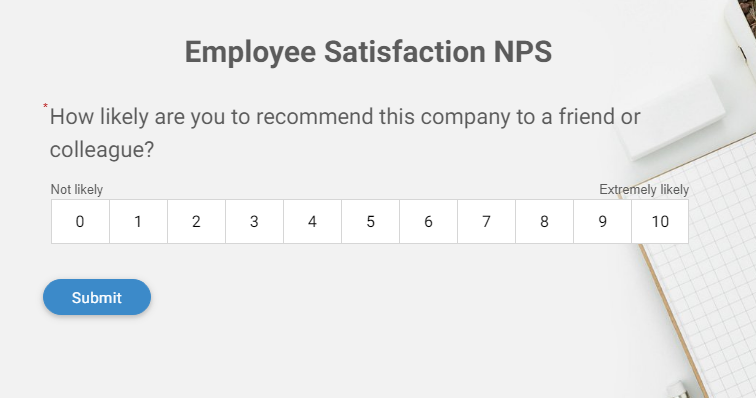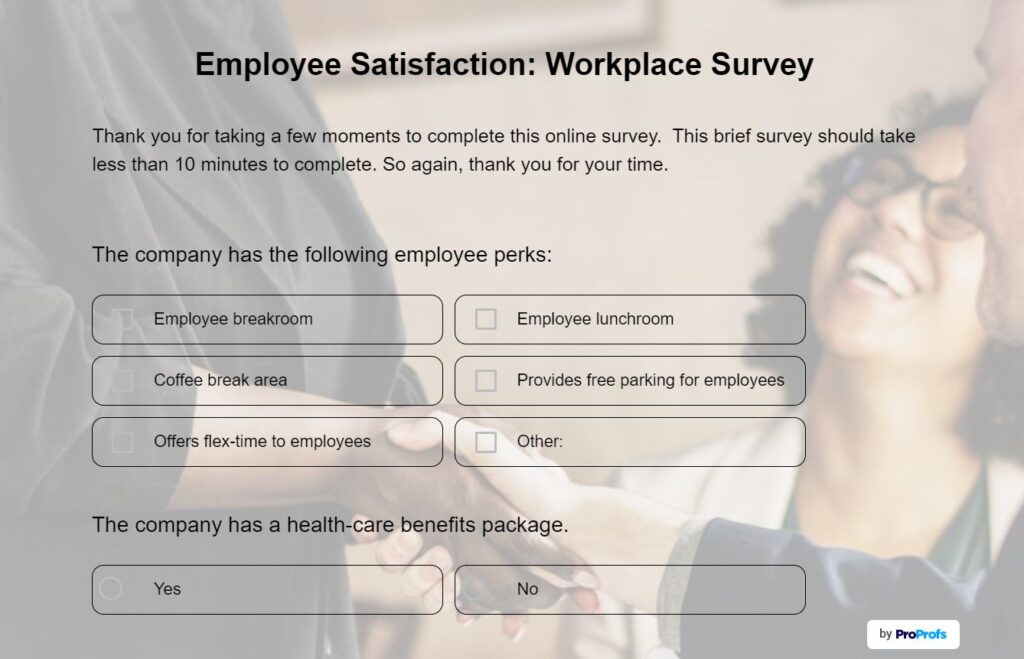
Customer loyalty is often highlighted as a cornerstone of success, but who ensures your brand consistently earns the trust and satisfaction of loyal customers? The answer is clear: your employees.
Therefore, asking good eNPS survey questions from time to time and actively responding to factors that could affect the score is what will keep your business on top.
Let’s back this up with some data. A recent study by Gallup found that engaged employees resulted in a 10% boost in customer loyalty, 18% more productivity in sales, and a 23% increase in overall profitability.
Source: Gallup
In this blog, we will explore the role of eNPS in measuring employee loyalty and 20+ eNPS questions that you can use in your survey right away.
What Is eNPS?
Employee Net Promoter Survey, or eNPS, is a tool for measuring employee satisfaction and loyalty by assessing their likelihood of recommending your organization as a great place to work.

Inspired by the Net Promoter Score (NPS) used to gauge customer loyalty, eNPS focuses on your workforce, offering insights into how employees perceive their workplace and their willingness to recommend it as a great place to work.
Precisely put, eNPS evaluates how connected employees feel to your organization. By asking a simple question, such as, “On a scale from 0 to 10, how likely are you to recommend this company as a place to work?” it categorizes employees into three groups:
- Promoters (scores 9–10): Loyal and enthusiastic employees who actively support and advocate for the organization.
- Passives (scores 7–8): Satisfied but not fully engaged employees who may not be actively promoting the company.
- Detractors (scores 0–6): Disengaged employees who might share negative experiences and reduce team morale.
Types of eNPS Questions for Comprehensive Insights
While the standard eNPS question serves as a starting point, incorporating a variety of question types helps uncover deeper insights into employee sentiment. Each type of question has a specific purpose, and together, they create a well-rounded picture of your workplace culture.
1. Core Loyalty Question
This is the heart of eNPS surveys. It directly measures the likelihood of employees recommending your organization as a workplace, providing a clear indicator of overall sentiment:
- “On a scale of 0 to 10, how likely are you to recommend this company as a place to work?”
This question gives way to deeper analysis and is therefore important for benchmarking employee loyalty.
2. Open-Ended Questions
Open-ended questions let employees freely share their thoughts. They provide context for the scores your organization receives and reveal insights that wouldn’t have surfaced in response to close-ended or rating questions. Some examples are:
- “What influenced your score?”
- “What do you think we could improve as an organization?”
- “What’s the best thing about working here?”
These questions are important because they capture nuances, emotions, and specific issues that employees face. They are most effective in revealing recurring themes, such as communication gaps, management concerns, or workplace culture strengths. Use them when you want qualitative insights to complement your numerical eNPS data, particularly in employee feedback sessions or pulse surveys.
3. Workplace Environment Questions
Workplace environment questions probe into employees’ experiences in their day-to-day work environment and focus mainly on factors such as resources, collaboration, and general support:
“Do you feel you have the tools and resources needed to do your job effectively?”
“How would you rate the level of collaboration within your team?”
They help identify barriers that impact productivity and satisfaction, and are crucial in industries or roles where employees depend on teamwork, equipment, or structured processes.

4. Leadership and Communication Questions
These questions measure the employee’s view on the effectiveness of the leadership group and whether proper communication channels have been created or not:
- “Are you comfortable trusting the leadership team to work in your best interest?”
- “Is the way the organization is informing you about anything satisfactory?”
They are especially useful in times of organizational changes, like mergers, restructuring, or leadership changes. You can ask these to gauge whether the transition is smooth for your employees or if they are facing any challenges.
5. Growth and Development Questions
Employees are engaged and committed as long as they feel they can grow and enhance their skills on the job. These questions address issues of career growth and learning, such as
- “Do you perceive that the organization supports your development as a professional?”
- “Are you satisfied with your training and development programs?”
Growth-related questions are important in industries with high turnover rates or roles that require continuous updates of skills. They help the organization understand whether the employees feel stagnant or supported in their career journey. This data can also be used further to create targeted initiatives to retain top talent and boost engagement.
20+ Best eNPS Survey Questions to Ask
An effective eNPS survey doesn’t stop at the classic, “How likely are you to recommend this company as a place to work?” For a comprehensive understanding of employee engagement and satisfaction, include follow-up questions from various categories. Below are 20+ questions to consider:
1. General Sentiment:
- What is the primary reason for your score?
- What do you like most about working at [Company Name]?
- What do you like least about working at [Company Name]?
- What could the company do to improve your experience?
2. Engagement & Motivation:
- I feel proud to work for [Company Name]. (Strongly Agree to Strongly Disagree)
- I am motivated to help [Company Name] succeed. (Strongly Agree to Strongly Disagree)
- I feel a sense of excitement about coming to work most days. (Yes/No)
- I’m always willing to go the extra mile for [Company Name]. (Strongly Agree to Strongly Disagree)
3. Culture & Values:
- How well do you feel the company lives up to its stated values? (Scale of 1-5)
- Do you feel valued and heard at [Company Name]? (Yes/No)
- How would you describe the company culture at [Company Name]? (Open-ended)
4. Management & Leadership:
- How effectively does your manager communicate with the team? (Scale of 1-5)
- How would you rate your manager’s support? (Scale of 0-10)
- Do you feel you have opportunities for growth within the company? (Yes/No)
5. Work Environment:
- How satisfied are you with your work-life balance? (Scale of 1-5)
- Do you have the resources and tools you need to do your job effectively? (Yes/No)
- How would you rate your overall work environment? (Scale of 1-5)
6. Future-Oriented:
- Do you see yourself working at [Company Name] in the next 2-3 years? (Yes/No/Maybe)
- How likely are you to apply for other positions within the company? (Scale of 1-5)
7. Training and Development:
- How satisfied are you with the training and development opportunities offered by the company? (Scale of 1-5)
- Do you feel the company supports your professional growth and development? (Yes/No)
- Have you participated in any training programs in the past year? (Yes/No)
- If yes, how would you rate the quality of these programs? (Scale of 1-5)
- What kind of training or development opportunities would you like to see offered in the future? (Open-ended)
How Can eNPS Surveys Increase Employee Engagement?
eNPS surveys, when done right, can be a powerful tool to boost employee engagement. Here’s how:
1. Giving Employees a Voice
Wouldn’t it be amazing if you could truly understand what your employees are thinking and feeling? An eNPS survey can be that bridge. When people feel heard and valued, they become more invested in their work and contribute with passion. Plus, it opens up a channel for honest and transparent communication, which is essential for building a strong and thriving company culture.
2. Identifying and Addressing Pain Points
eNPS surveys can bring to light hidden issues that might otherwise go unnoticed. This allows you to proactively address problems before they escalate and impact engagement. By analyzing the responses, you can pinpoint specific areas for improvement, whether it’s leadership, work-life balance, or career development opportunities.
3. Demonstrating Commitment to Improvement
When you take action based on the feedback received, you demonstrate to employees that their input truly matters. This shows a commitment to creating a better workplace, which in turn fuels engagement. Regularly conducting eNPS surveys reinforces this commitment and signals to employees that the organization is dedicated to continuous improvement.
4. Cultivating a Culture of Honest Feedback
eNPS surveys help make feedback a normal part of your company culture. This encourages ongoing dialogue and a sense of shared responsibility for improvement. By actively seeking and responding to feedback, you promote a growth mindset within the organization, which can be highly motivating for employees.
5. Recognizing and Reinforcing Positives
While eNPS surveys help you identify areas for improvement, they also highlight what your company is doing well. Take the time to celebrate these successes and acknowledge your strengths. This boosts morale and reinforces positive behaviors.
Watch: How to Create Awesome Employee Engagement Surveys: 6 Quick Tips
How to Use Employee Net Promoter Score Effectively?
Measuring Employee Net Promoter Score (eNPS) is just the beginning; what you do with the results determines its true value. To use eNPS effectively, organizations need to take a systematic approach that not only captures employee sentiment but also translates it into meaningful action. Here’s how:
- Understand the Data in Context: Don’t view the eNPS score in isolation. Analyze it alongside other employee engagement metrics and qualitative feedback to get a holistic picture of your workplace environment. Consider trends over time to identify patterns rather than reacting to one-time results.
- Segment Responses: Break down your eNPS data by departments, roles, or demographics to know your organization’s areas of strength and concern. A high overall score might mask dissatisfaction in certain teams or locations.
- Listen to Open-Ended Feedback: Pay close attention to the qualitative feedback employees provide. Their explanations for their scores often reveal actionable insights that a number alone cannot.
- Communicate the Results Transparently: Share the findings with your employees. Transparency builds trust and shows that their input is valued. Use this opportunity to outline the next steps based on their feedback.
- Act on the Insights: The most critical step is turning insights into action. Address areas of concern, celebrate successes and implement initiatives that resonate with employees. Quick wins can boost morale, while long-term plans signal a commitment to improvement.
- Close the Feedback Loop: Regularly update employees on the progress of the actions taken. Let them know how their feedback has influenced change, which reinforces their role in shaping the workplace.
- Incorporate eNPS Into Broader Strategies: Use eNPS as a part of your ongoing employee engagement strategy. Combine it with other tools and initiatives to create a comprehensive approach to enhancing the employee experience.
- Measure Continuously: Engagement is not static. Conduct eNPS surveys regularly to monitor progress and adapt to evolving employee needs and expectations.
Best Practices for eNPS Surveys
To get the most out of your eNPS surveys, follow these 8 best practices:
1. Timing is Everything: Choose the Right Moment
Don’t ambush your employees with a survey out of the blue. Choose a time when they’re likely to be more receptive and have the headspace to provide thoughtful feedback. Consider factors like major deadlines, company events, or periods of significant change within the organization.
2. Keep it Short
No one wants to wade through a lengthy survey. Keep your eNPS questionnaire concise and focused, ideally taking no more than 5-10 minutes to complete. Prioritize the most important questions and avoid overwhelming your team with unnecessary detail.
3. Speak Their Language
Avoid jargon, technical terms, or overly complex language. Use clear, concise, and easily understandable language that resonates with your employees. The goal is to make the survey accessible and encourage honest, straightforward responses.
4. Guarantee Anonymity
To encourage candid feedback, ensure that responses are completely anonymous. Employees need to feel safe expressing their true opinions without fear of repercussions. Clearly communicate the anonymity of the survey and emphasize that honest feedback is crucial for improvement.
5. Ask the “Why” Behind the Score
Don’t just focus on the numerical score. Include open-ended questions that encourage employees to elaborate on their ratings. Ask questions like:
- “What is the primary reason for your score?”
- “What could the company do to improve your experience?”
- “What do you value most about working here?”
These qualitative insights provide valuable context and help you understand the drivers behind employee sentiment.
6. Make it Mobile-Friendly
In today’s world, people access information on various devices. Ensure your eNPS survey is mobile-friendly so employees can easily complete it on their smartphones or tablets. This increases accessibility and encourages higher participation rates.
7. Don’t Just Collect, Act!
The true value of eNPS lies in taking action based on the feedback received. Analyze the results, identify key trends and areas for improvement, and develop a plan to address them. Communicate your action plan to your employees and demonstrate that their feedback is being taken seriously.
8. Follow Up and Show You Care
After taking action based on the initial survey, send a follow-up communication to your employees. Acknowledge their feedback, highlight the changes you’ve implemented, and reiterate your commitment to continuous improvement. This demonstrates that you’re listening and that their opinions matter.
Build a Loyal Workforce by Conducting Regular eNPS Surveys
Employee Net Promoter Score (eNPS) is a gateway to understanding your workforce and creating a more engaged and committed team. Once you analyze your loyalty scores and understand the why behind them, acting on employee feedback becomes much easier!
However, how successfully you can use the eNPS lies in how well you use the insights. That means segmenting responses, addressing specific challenges, transparent communication, and regular follow-ups.
A dedicated eNPS tool can streamline the process for you. One such tool is ProProfs Survey Maker, which has a readymade eNPS template, AI survey generator, instant report analysis, and multiple sharing options!
Let’s turn feedback into action and create a workplace where employees thrive and your organization excels.
FREE. All Features. FOREVER!
Try our Forever FREE account with all premium features!





